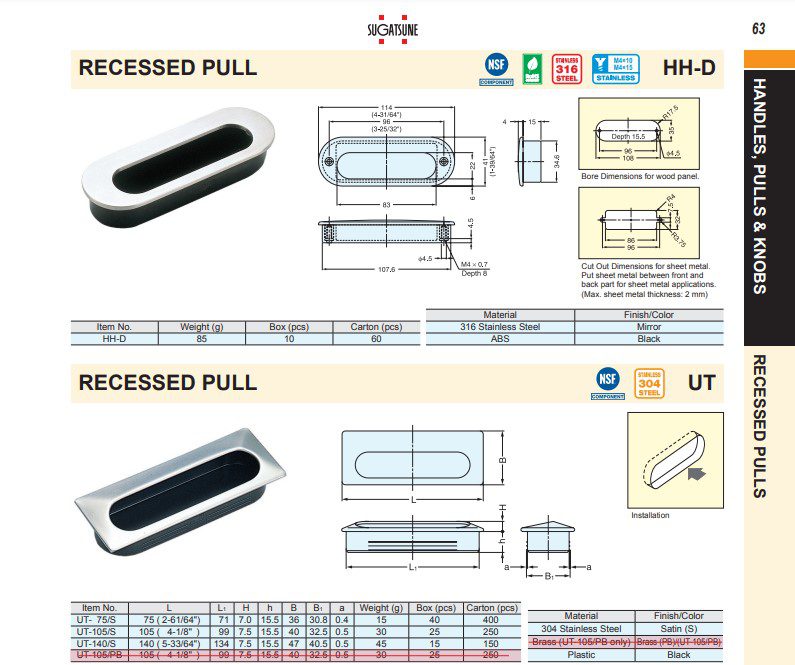The Different Types of Stainless Steel & Their Benefits
Posted On Aug 31st 2023
Posted On Aug 31st 2023
Posted On Aug 31st 2023
Sugatsune America, has become well known for our prominent use stainless steel, in our architectural and industrial hardware products. It prolongs the life of hardware and can make work environments look more professional and operate more safely and hygienically.
Here are just a few of the key benefits of stainless steel that make it such a good material for us:
We routinely use stainless steel over cheaper materials whenever there is a clear performance benefit to be gained. We also use it for its handsome display properties, as stainless steel’s shiny, clean, modern appearance adds a premium to luxury spaces.
But all steel is not created equally, so today, we are looking at the different types of stainless steel we use in our hardware.
Stainless steel is graded according to the proportions of its constituent components. This isn’t a hierarchical grading system like the A – F scale in school. Rather, different grades of steel serve different purposes, and the specific benefits of stainless steel differ according to their grade. So don’t think about different grades of steel as “good” or “bad.” It’s all about finding the right grade of steel for the job!
Many types of stainless steel grading systems are used in the US and worldwide. The one most commonly known among project managers, architects, trade professionals, and others who make up our customer base is the three-digit system developed by the Society of Automotive Engineers. This system is where names like “Grade 304 Stainless Steel” come from. This same type of stainless steel (Grade 304) is also classified under different systems as “18/8,” “A2,” “1.4305,” “X8CrNiN18-9,” and “S30400”—just to name a few examples.
The differences in the grades of stainless steel are a result of their distinct compositions and properties. The key difference between these grades lies in their alloy composition, corrosion resistance, strength, and applications.
The three-digit SAE grades are an older way of grading stainless steel, but pretty much everyone knows this system, and it covers most applications. So this is the system we use at Sugatsune, and in our Product Catalogs, you will usually see an icon at the top of each product listing to indicate which grade of stainless steel (if any) is the featured steel in that product:

Grade 304 is primarily composed of 18% chromium and 8% nickel making it one of the most common austenitic stainless steel grades because its corrosion resistance and strength are the most sought after benefits of stainless steel. Used in everything from pots and pans to kitchen appliances and sinks, to vats and tubing, to simple nuts and screws, Grade 304 makes up roughly half of all stainless steel production in the world—and is by far the most common stainless steel that we use at Sugatsune. You will find it in everything from our hinges and brackets to our hooks and handles.
Of all the different types of stainless steel, Grade 304 has the most popular balance of characteristics, such as:
At Sugatsune, we particularly value the benefits of stainless steel Grade 304 for its corrosion resistance due to contact with water. Many of our hardware components are designed to be used in environments where repeated water exposure is possible or even expected. Whether it be a simple wipe-down of food preparation equipment, or a lock facing exposure to the rain, Grade 304 steel will resist rusting, pitting, and weakening for many years.
This is the next most common of all types of stainless steel in the world and at Sugatsune as well. Grade 316 includes molybdenum in its composition, granting it excellent resistance to corrosion by chlorides, i.e. salt. In other words, 316 is:
We most often use Grade 316 stainless steel for hardware intended for use in marine applications—i.e., on seagoing boats, coastal properties, etc. You will often find it in marine-rated latches and pulls. Grade 316 can also be used for food preparation surfaces, non-magnetic surgical instruments, and chemical storage applications.
Like many other types of stainless steel, Grade 316 types of stainless is mildly more expensive than Grade 304, owing to the molybdenum and increased nickel content and because Grade 304 benefits from excellent economies of scale due to its high demand. Nevertheless, whenever saltwater corrosion resistance is called for, Grade 316 is the superior choice over 304.
The most common magnetic (i.e. ferritic) types of stainless steel typically begin with a 4. If there is an application-based need for the magnetic property, we will use this over a 300 series steel. Additionally, there are some other benefits of stainless steel in the 400 series:
We use quite a few other types of stainless steel as well here at Sugatsune because, as mentioned, each grade has different performance characteristics, so we choose the type carefully. Here are some of the key benefits of stainless steel grades that we use in our products:
We hope this discussion of the different benefits of stainless steel helps you better understand which types of stainless steel to look for when you’re sourcing hardware for your project.
Contact us if you have any questions about our steel or anything else.
CAD files are available on each product’s detail page. Click the “CAD/BIM Files” tab, located in the middle of the page to download the different formats. If CAD files are not available for a specific component, please contact our Support Team
Toll Free: (800) 562-5267 (U.S.A. only)